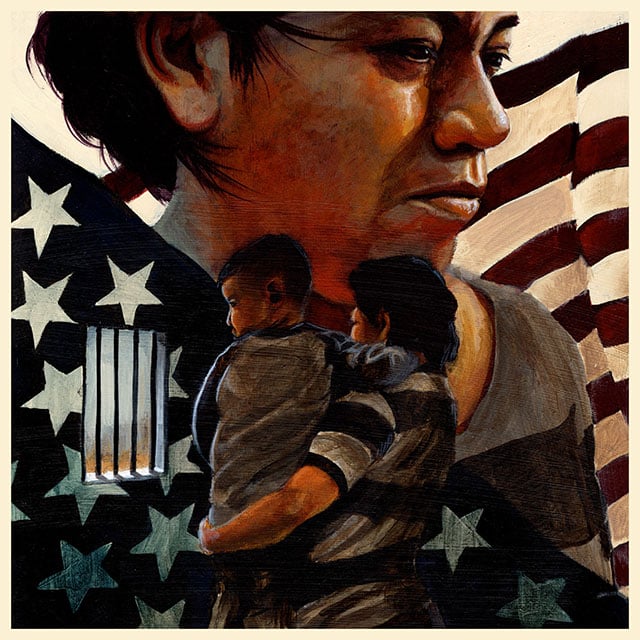
 “I’m choosing this imagery because I think people forget that these detention centers are prisons and sometimes have harsher conditions. The figure of a woman and her child in a desolate cell is eye opening. I don’t want to victimize her but I also want to be real about her struggle. I think I’d like viewers to feel a simple level of human connection to this woman’s struggle. And through that connection find the strength to continue their own struggle if they are also detained or be in solidarity with her.” (Image: Zeke Peña / CultureStrike)
“I’m choosing this imagery because I think people forget that these detention centers are prisons and sometimes have harsher conditions. The figure of a woman and her child in a desolate cell is eye opening. I don’t want to victimize her but I also want to be real about her struggle. I think I’d like viewers to feel a simple level of human connection to this woman’s struggle. And through that connection find the strength to continue their own struggle if they are also detained or be in solidarity with her.” (Image: Zeke Peña / CultureStrike)
If you went by the GEO Group’s description, you’d never know the “Karnes County Residential Center” in Karnes City, Texas, is actually a jail for undocumented immigrants. According to the world’s leading provider of “correctional and detention management and community reentry services,” Karnes County Residential Center is “a safe, clean, and family friendly environment for families under the care of U.S. Immigration and Customs Enforcement (ICE).”
The women detained within the detention center describe it differently.
In the past year alone, horrendous stories have emerged from Karnes, like the story of Nayely, the 7-year-old girl with terminal brain cancer whom ICE refused to release from the detention center for treatment, even after her mother passed a credible fear interview, which usually makes the person qualified for asylum. In October 2014, accusations of sexual abuse in the Karnes detention center surfaced, with multiple women alleging they were removed from their cells during early morning hours for the purpose of being sexually assaulted. It has also been alleged that women detainees were kissed, fondled and groped in front of other detainees, including children.
News stories are one thing, but nothing paints a more accurate picture of the horrors taking place inside Karnes than the words of the women imprisoned inside. In a powerful new project inspired by the work of an organization called End Family Detention, activists and artists have been centering these women’s words, moving beyond the statistics to humanize the horrors of detention.
Letters From Inside
“Letters From Inside” could not have happened without the labors of Iris Rodriguez, a Chicana multimedia activist who worked with other organizations and attorneys representing detained women to smuggle out letters they wrote that detail the conditions inside.
Rodriguez is the web master at End Family Detention, a digital library composed of a network of families, volunteers, pro bono lawyers, social justice organizers and digital activists dedicated to raising awareness and promoting action to end family detention.
Every time she got a new letter from a woman imprisoned in a detention center, she digitized and uploaded it to her site. Then the letters were translated by volunteers in order to reach a wider audience.
“We have to put real faces to these stories; they are not just statistics.”
“It’s critically important that the voices we’re hearing in these letters comes from brown women,” Rodriguez said. “So often, the stories that get reported about ‘immigrants’ lack historical context; we don’t hear about the colonized history of indigenous women. Being able to take their words and digitize them for the world to see, saving the letters from being burned and forgotten, is a radical act.”
She added that “family detention centers” primarily house women and children. More broadly, women are disproportionately affected by the broken immigration system, the human rights abuses in detention centers and the deportation of members of their family.
In June, End Family Detention posted exactly the kind of letter ICE doesn’t want people to see. It was a letter from Lilian Oliva, a 19-year-old mother who was discovered in a family detention center bathroom bleeding from cuts to her wrist. Oliva came to the United States to escape violence in her native Honduras, only to spend eight months in detention and eventually get deported by the Obama administration – but not without first giving End Family Detention permission to post her suicide note. In part, it read:
I come here so this country can help me but here you’ve been killing me little by little with punishment and lies in prison when I haven’t committed any crime … Maybe you are not fathers or mothers to understand the reasons and the suffering that we live in this place together with our children. You would not like to be locked up in a place like this the way we are here suffering with our children.
Stories like Oliva’s are sadly common. As journalist Michelle Chen recently wrote for The Nation, women are being held for months in inhumane detention centers just for fleeing violence and other hardships in their countries of origin.
Yahaira Carrillo’s mother was one of these women. Leaving Mexico shortly after the Mexico City earthquake, fleeing an abusive relationship, Carrillo’s mother made her way to the United States with a 1-year-old Carrillo in tow. Carrillo would go on to become a central part of the undocumented student movement that began to emerge around 2010. She was one of the first undocumented students in US history to risk deportation while participating in an act of civil disobedience in Sen. John McCain’s office, a decision that landed her in ICE processing, unsure if she would be placed in deportation proceedings.
Carrillo is now managing director of CultureStrike, an artists’ network and national nonprofit organization focusing on immigrant rights. After Carrillo and other CultureStrike employees took a border trip earlier this year, meeting with artists and organizers to discuss how living on the border impacts the way communities facing detention function, CultureStrike decided it wanted to tackle a new project that would shine a light on the stories they were hearing.
Mariposas Sin Fronteras, a group based in Tucson, Arizona, that seeks to end the systemic violence and abuse of LGBTQ people held in prison and immigration detention, shared letters with CultureStrike from LGBTQ detainees. The organization facilitated a letter writing program in local detention centers to help detainees feel less alone. For Carrillo, a queer, undocumented woman, the letters hit home.
“The letters were so powerful and raw and when we returned to Oakland, we kept going back to letter writing when brainstorming ideas,” Carrillo said. “I know for a fact that if I were placed in detention after my arrest, I would have relied on writing. There is nothing else in there. There’s nothing to do to get out of your own head because there’s no way to communicate with anyone on the outside if you don’t have money to use the phone. If no one knows you’re in there, if no one visits you, it’s like you don’t exist. Now imagine months of that. In some cases, it’s years. Letter writing becomes an outlet, something that feels liberating when you’re being imprisoned.”
Telling a Visual Story
Using letter writing as an entry point to tell a visual story, CultureStrike partnered with Rodriguez for “Visions From Inside,” which uses letters collected and published by End Family Detention as a source of inspiration for 15 artists, each of whom illustrated a detainee’s letter. Throughout the project, artists received feedback from authors of these letters via their attorneys, ensuring that the illustrations stayed true to their stories.
“We believe it’s important to illustrate things in a way that is visual and impactful and this project in particular upsets the usual ‘migrant as subject’ paradigm,” Carrillo said. “‘Visions From Inside’ makes the migrant both the subject and co-creator because these are their lived experiences; they bring the migrant lens. Non-migrant artists can feel deeply about these subjects, but they don’t know what it’s like. By being co-collaborators in the process of telling their stories, the migrants can feel more empowered.”
The 15 letters that were used for “Visions From Inside” all came from women detained in Karnes detention center. The timing for the project is interesting. If recent headlines are any indication, immigration will continue to be a controversial topic as we move into election season. At the same time, there continues to be a surge of Central American women migrants and unaccompanied minors – young children traveling alone – fleeing violence in their home countries.
According to CultureStrike, those who do survive the dangerous trek from Central America through Mexico are often detained at the US-Mexico border and placed in detention centers like Karnes, where they face the kind of abuse they were attempting to escape in the first place.
It was only last year when presidential candidate Hillary Clinton said that unaccompanied minors should be “sent back.” An internal memo from the US Border Patrol from May 2014 reported that 90,000 minors would be apprehended that year and as many as 142,000 this year. These are primarily children from Guatemala, Honduras and El Salvador, sometimes as young as 6 years old, being driven away from their homes by gang-related violence.
Often, immigration is presented as such a polarizing issue, discussed politically in a detached way that makes it clear there is little understanding of how immigration policies ravage migrant families, tearing them apart.
Artist Micah Bazant illustrated a letter from a young mother who is an orphan from Guatemala. The letter writer’s husband was murdered, and she and her daughter were also threatened with murder before she left for the United States. In her letter, the woman expresses her desperation, asking for help and saying the water in detention has bleach in it and she doesn’t have money to buy water.
In response, Bazant created an image of a mighty waterfall breaking through the prison walls, delivering the wished-for water to the mother and child.
Bazant – a first generation US citizen whose family escaped Nazi Europe – notes that even sympathetic media coverage of immigration often focuses narrowly on the present-day reality of immigration laws being broken.
Insisting on the Humanity of Migrants
CultureStrike sees “Visions From Inside” as an opportunity to get people to see the humanity of migrants, whether they agree or disagree with immigration policies. Carrillo says it doesn’t even matter what political party you’re a member of.
“That is all besides the point,” the managing director said. “We can all understand family. We can understand wanting to be with our families, wanting better for our families. This project highlights loving relationships between people, period.”
One of the artists participating in the project is a migrant who was detained at the US-Mexico border with his mother when he was 7 years old. Fidencio Martinez can still remember being in detention, an experience he said was “dehumanizing and demoralizing.”
Martinez emerged as an artist around the same time Carrillo emerged as an activist.
“There was a national movement aimed at changing the dialogue around immigrants, specifically undocumented immigrant youth. There were hundreds of DREAMers coming out of the shadows and as an undocumented queer person, I finally had the courage to come out,” the artist said.
Two years ago, Martinez applied for deferred action and one of the prerequisites requires proof for nearly every month migrants have been in the United States.
“I had newspaper articles, show invitations, awards and college records. The very work that was criticizing the way immigrants are being treated in the US, I used as proof of my existence,” Martinez said.
As part of CultureStrike’s project, Martinez illustrated a letter from a woman named Melissa, who was detained with her sisters and mother. She wrote, in part:
We need the help of all of you because we feel depressed and forgotten in this place … Yesterday 10/30/14 to see that 38 families were deported from here after months of being here has made us feel deceived. This country has been deceiving.
Martinez’s image is split into 12 black-and-white scenes, each showcasing a small cell featuring nothing more than a bed, a mother and her baby. The artist wanted to focus on a mother and child in hopes of conveying a bigger story.
“Melissa, her sisters and mother traveled hundreds of miles in order to look for a better future. Their mother made that choice because she had to,” Martinez said. “I remember how my mother said it was better to die on our way to the US than to die of starvation. Those decisions mean saying goodbye to family, friends, everything you knew for the mere possibility of something better. Women like Melissa made the journey, sacrificed all they knew, only to live a hell at Karnes family prison. We have to put real faces to these stories; they are not just statistics. These are people that have dreams, love, families, and they are being treated like animals.”
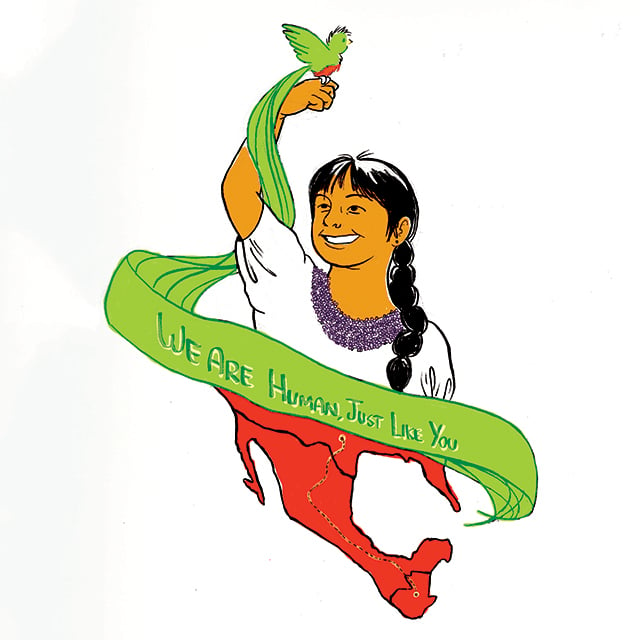 “The nation of Guatemala has endured globalization, extreme poverty and violence; which is why I can understand why so many are migrating away from this land. This young woman has a quetzal perched on top of her hand in order to express the need for liberation and family togetherness. The quetzal is a special bird because it cannot survive within captivity, therefore I feel that the migrant youth and mothers carry that [same] need – to be liberated from these prisons and from oppressive forces in Central America. I wanted to condense Angie’s quote to ‘we are human, just like you’ to remind North America that these brave souls are seeking opportunity to enhance the quality of life for their children.” (Image: Breena Nuñez / CultureStrike)
“The nation of Guatemala has endured globalization, extreme poverty and violence; which is why I can understand why so many are migrating away from this land. This young woman has a quetzal perched on top of her hand in order to express the need for liberation and family togetherness. The quetzal is a special bird because it cannot survive within captivity, therefore I feel that the migrant youth and mothers carry that [same] need – to be liberated from these prisons and from oppressive forces in Central America. I wanted to condense Angie’s quote to ‘we are human, just like you’ to remind North America that these brave souls are seeking opportunity to enhance the quality of life for their children.” (Image: Breena Nuñez / CultureStrike)
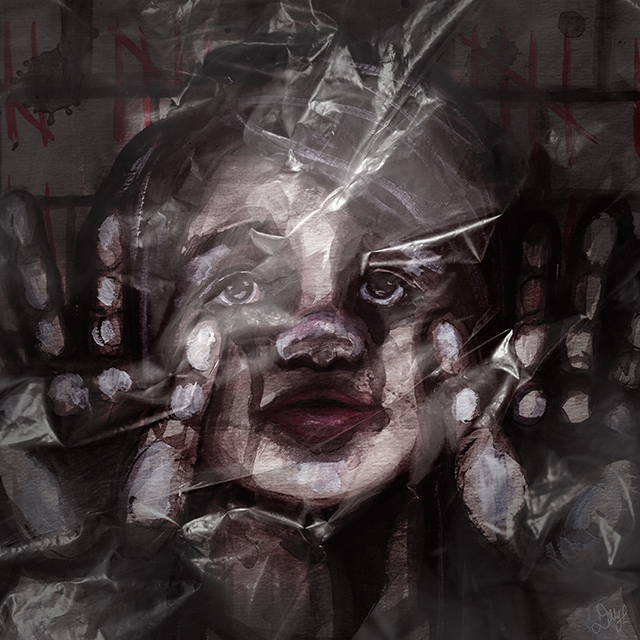 “It is damning to realize that we live in a society that keeps young people from learning, from participating in their own childhood, from creating and nurturing friendships. Jackeline’s earnest words force us to pause and consider why we would keep a young girl locked in a place often worse than prison. In my illustration, I wanted to evoke the sensations of feeling trapped and suffocated to show that immigration detention is not a humane place for anyone to exist in, let alone a child. How can we justify keeping Jackeline from an education when learning is all she can dream of? How can we justify Jackeline losing her friends, multiples at a time? How can we justify spending so much money on keeping Jackeline and her family locked in a place that only breeds depression? Our society needs to be reminded that being an immigrant does not make you any less human.” (Image: Dolly Lee / CultureStrike)
“It is damning to realize that we live in a society that keeps young people from learning, from participating in their own childhood, from creating and nurturing friendships. Jackeline’s earnest words force us to pause and consider why we would keep a young girl locked in a place often worse than prison. In my illustration, I wanted to evoke the sensations of feeling trapped and suffocated to show that immigration detention is not a humane place for anyone to exist in, let alone a child. How can we justify keeping Jackeline from an education when learning is all she can dream of? How can we justify Jackeline losing her friends, multiples at a time? How can we justify spending so much money on keeping Jackeline and her family locked in a place that only breeds depression? Our society needs to be reminded that being an immigrant does not make you any less human.” (Image: Dolly Lee / CultureStrike)
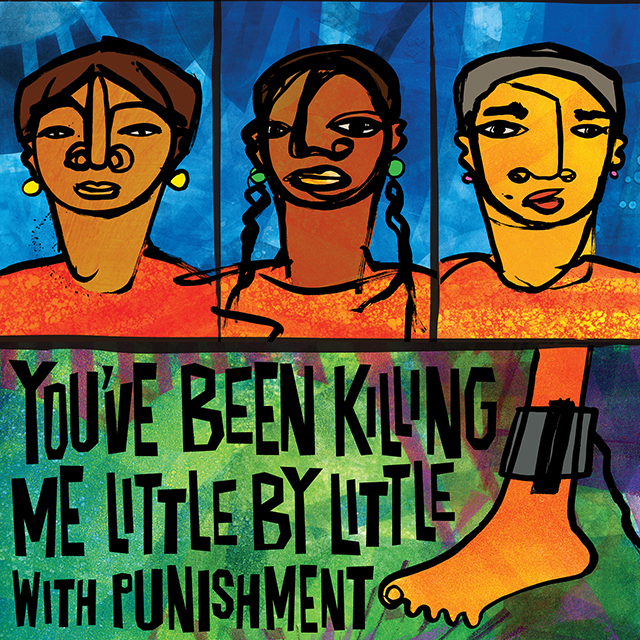 “I created this piece to depict both the dignity and the suffering that women endure in for-profit detention centers. The women detained in Karnes County Detention Center have endured physical abuse, rape by prison guards, and the constant sicknesses of their children. In this piece, I wanted to show the ways in which prison degrades and abuses women. I used a jagged brush stroke to show the harshness of detention, and the human suffering of women who come to this country in search of a safe haven. This piece should reminds us that detention is still the reality in the US, continually defended by the Obama administration. Although some women are being released, they are forced to wear ankle monitoring bracelets. The text in the piece is an excerpt from a letter by Lilian Oliva, age 19, who was discovered in a family detention center bathroom bleeding from cuts to her wrist. Her letter said, ‘You don’t understand that people’s lives has no price…I come here so this country can help me but here you’ve been killing me little by little with punishment and lies in prison when I haven’t committed any crime.’ Lilian, who had been held with her 4-year-old son since October 2014, was deported in June 2015.” (Image: Favianna / CultureStrike)
“I created this piece to depict both the dignity and the suffering that women endure in for-profit detention centers. The women detained in Karnes County Detention Center have endured physical abuse, rape by prison guards, and the constant sicknesses of their children. In this piece, I wanted to show the ways in which prison degrades and abuses women. I used a jagged brush stroke to show the harshness of detention, and the human suffering of women who come to this country in search of a safe haven. This piece should reminds us that detention is still the reality in the US, continually defended by the Obama administration. Although some women are being released, they are forced to wear ankle monitoring bracelets. The text in the piece is an excerpt from a letter by Lilian Oliva, age 19, who was discovered in a family detention center bathroom bleeding from cuts to her wrist. Her letter said, ‘You don’t understand that people’s lives has no price…I come here so this country can help me but here you’ve been killing me little by little with punishment and lies in prison when I haven’t committed any crime.’ Lilian, who had been held with her 4-year-old son since October 2014, was deported in June 2015.” (Image: Favianna / CultureStrike)
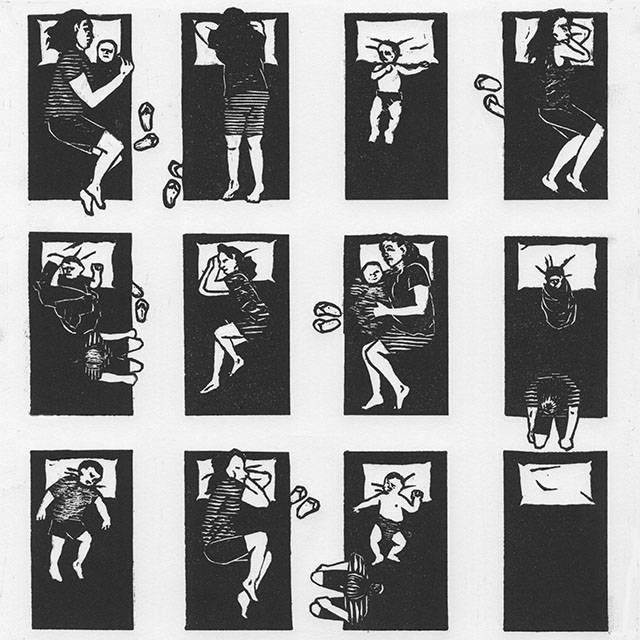 “I chose images of mothers holding children because I remember how it felt to be placed in ICE detention. All I wanted was the comfort of my mother and I think that the women are incredibly brave, strong and noble in those situations. [Even in detention] they are still fighting for the safety and well being of their children.” (Image: Fidencio Martinez / CultureStrike)
“I chose images of mothers holding children because I remember how it felt to be placed in ICE detention. All I wanted was the comfort of my mother and I think that the women are incredibly brave, strong and noble in those situations. [Even in detention] they are still fighting for the safety and well being of their children.” (Image: Fidencio Martinez / CultureStrike)
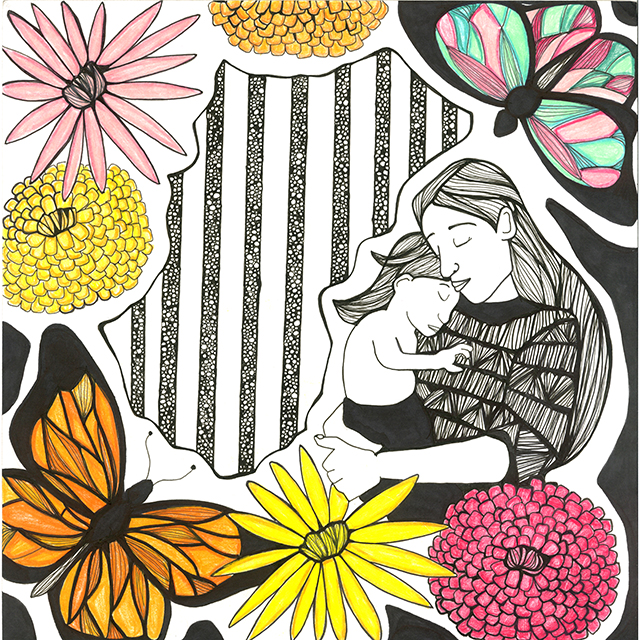 “What inspires my drawing is the spirit and resiliency of our peoples, womyn and children in particular, who continue to live, resist and love each other despite the borders and prisons that tear apart our families and communities. I was moved by the strength of the mother in the letter, and mothers everywhere who continue to nurture life through their love. I wanted that to be reflected in the drawing with the mother and child close, embraced by the earth, flowers, butterflies, [and] ancestors. A reflection of what we are fighting for; our communities and families.” (Image: Francis Mead / Culturestrike)
“What inspires my drawing is the spirit and resiliency of our peoples, womyn and children in particular, who continue to live, resist and love each other despite the borders and prisons that tear apart our families and communities. I was moved by the strength of the mother in the letter, and mothers everywhere who continue to nurture life through their love. I wanted that to be reflected in the drawing with the mother and child close, embraced by the earth, flowers, butterflies, [and] ancestors. A reflection of what we are fighting for; our communities and families.” (Image: Francis Mead / Culturestrike)
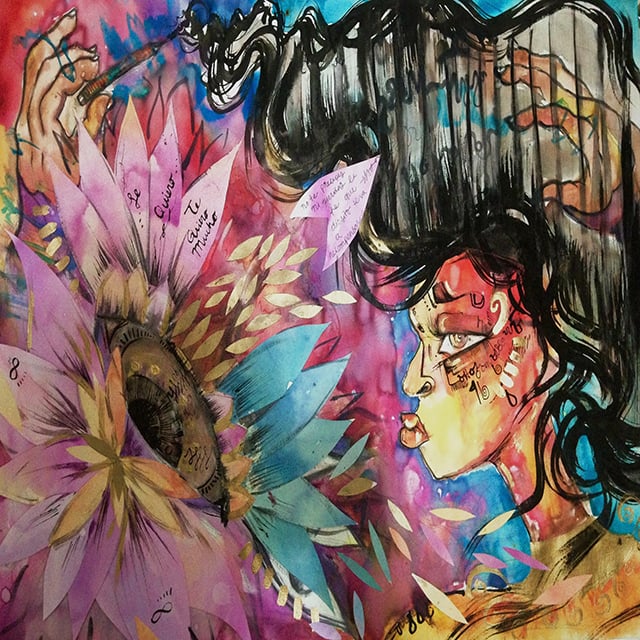 “In the letter, the girl wrote a lot about a higher force, about God, telling her to pray, to maintain strength, and telling her that ‘God will make it up to you.’ I found that really powerful and, unknowing of what their specific religious views are, I found it important to include something in the sketch representative of faith, hope, beauty, strength and a higher divine purpose throughout the ordeals of the struggles of life. The girls tears lead into a flower, and from the petals of the flower there are words from the letter, reaching into the direction of the girls hair, to a hand behind bars.” (Image: Gabrielle Tesfaye / CultureStrike)
“In the letter, the girl wrote a lot about a higher force, about God, telling her to pray, to maintain strength, and telling her that ‘God will make it up to you.’ I found that really powerful and, unknowing of what their specific religious views are, I found it important to include something in the sketch representative of faith, hope, beauty, strength and a higher divine purpose throughout the ordeals of the struggles of life. The girls tears lead into a flower, and from the petals of the flower there are words from the letter, reaching into the direction of the girls hair, to a hand behind bars.” (Image: Gabrielle Tesfaye / CultureStrike)
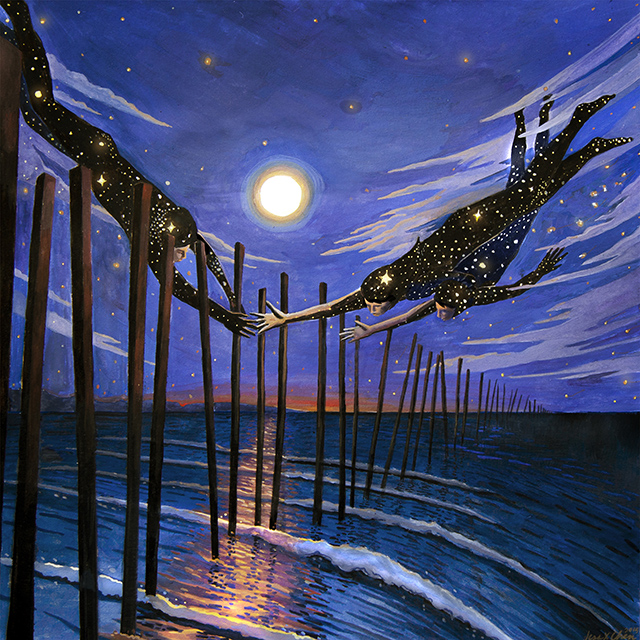 “A visual collaboration with a letter written by a Honduran mother who is being kept at Karnes County Detention Center with her younger son after attempting to cross the border to be reunited with her family. Despite the traumatic and abusive conditions she faces at Karnes, she and her younger son reach across the US-Mexico border to join hands with her older son who made it to Los Angeles. Their bodies are preserved with the light of a million stars, representing the millions of mothers, fathers, and children throughout history who attempt to cross the border into the US. Migrants risk enormous loss in the optimism of securing family and community in a new country. For as long as she lives, the Honduran mother, and millions of others, reach for each other and form constellations in the night despite the borders, detainments, and abuse of the US. This image is a tribute to their undefeatable optimism and resilience.” (Image: Jess X Chen / CultureStike)
“A visual collaboration with a letter written by a Honduran mother who is being kept at Karnes County Detention Center with her younger son after attempting to cross the border to be reunited with her family. Despite the traumatic and abusive conditions she faces at Karnes, she and her younger son reach across the US-Mexico border to join hands with her older son who made it to Los Angeles. Their bodies are preserved with the light of a million stars, representing the millions of mothers, fathers, and children throughout history who attempt to cross the border into the US. Migrants risk enormous loss in the optimism of securing family and community in a new country. For as long as she lives, the Honduran mother, and millions of others, reach for each other and form constellations in the night despite the borders, detainments, and abuse of the US. This image is a tribute to their undefeatable optimism and resilience.” (Image: Jess X Chen / CultureStike)
 “We cannot be okay with the thought that a mother has to celebrate their child’s birthday behind bars. Their crime was to be responsible and courageous because they defied borders in order to offer a better future for their children. How dare a government punish a mother’s heroism? Instead, we should be building monuments that celebrate their resistance.” (Image: Julio Salgado / CultureStrike)
“We cannot be okay with the thought that a mother has to celebrate their child’s birthday behind bars. Their crime was to be responsible and courageous because they defied borders in order to offer a better future for their children. How dare a government punish a mother’s heroism? Instead, we should be building monuments that celebrate their resistance.” (Image: Julio Salgado / CultureStrike)
 “Butterflies migrate and their migration is beautiful, they’re not restricted by physical borders. When humans restrict the beauty and nature of human migration it brings pain and trauma. It was important for me to incorporate these messages into the image of what migration should be and how detention and deportation are not only unnatural but they’re also detrimental. Rebecca’s letter illuminated the conditions that folks in detention are surviving day to day.” (Image: Chucha Marquez / CultureStrike)
“Butterflies migrate and their migration is beautiful, they’re not restricted by physical borders. When humans restrict the beauty and nature of human migration it brings pain and trauma. It was important for me to incorporate these messages into the image of what migration should be and how detention and deportation are not only unnatural but they’re also detrimental. Rebecca’s letter illuminated the conditions that folks in detention are surviving day to day.” (Image: Chucha Marquez / CultureStrike)
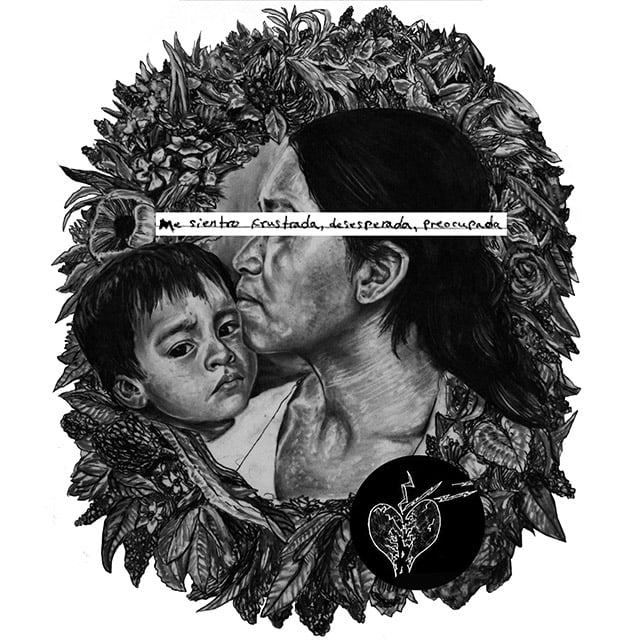 “I wanted to create a simple composition that focuses on the strength, selflessness, hope, and love of a mother who is enduring tortuous conditions because of a lack of a piece of paper. I covered the mother’s eyes with a phrase from her letter ‘Me siento frustrada, desesperada, y preocupada (I feel frustrated, desperate, and worried)’ exposing what lies within the struggling mother, that and a ‘Broken Heart’ drawing illustrated by the very mother whose letter I received. Not only does it express how she feels physically and psychologically but I felt that my illustration for this project wouldn’t be legitimate until some sort of (indirect) expressive collaboration with Sonia (the mother) took place.” (Image: Mata Ruda / Culturestrike)
“I wanted to create a simple composition that focuses on the strength, selflessness, hope, and love of a mother who is enduring tortuous conditions because of a lack of a piece of paper. I covered the mother’s eyes with a phrase from her letter ‘Me siento frustrada, desesperada, y preocupada (I feel frustrated, desperate, and worried)’ exposing what lies within the struggling mother, that and a ‘Broken Heart’ drawing illustrated by the very mother whose letter I received. Not only does it express how she feels physically and psychologically but I felt that my illustration for this project wouldn’t be legitimate until some sort of (indirect) expressive collaboration with Sonia (the mother) took place.” (Image: Mata Ruda / Culturestrike)
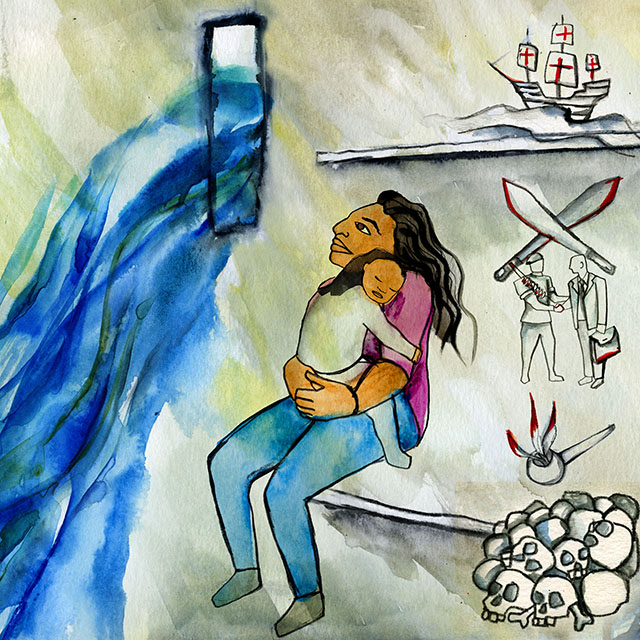 “The letter I illustrated was short and so heartbreaking. There was so much unsaid in it: so much strength, suffering and history. The author says, ‘I am an orphan, and my husband was murdered. I was also threatened, that I would be killed together with my daughter. I am also discriminated against because of my language, I don’t know how to speak Spanish.’ US dialogue about immigration usually starts with a focus on individuals who are breaking the law. But it’s a choice to start the story there – to start it after 500+ years of colonization + genocide of Mayan people; after the US-backed coup that led to 36 years of terror and war; after decades of US drug policies and multinational trade agreements that have decimated the economy and democratic governance, and fueled narcoviolence. The letter also said: ‘The water has bleach in it, and I don’t have money to buy water from the store.’ Water is life and water crosses borders. Clean water should be everyone’s birthright. When I imagined what I wished for this mother and her child, I imagined a mighty waterfall breaking through the prison walls.” (Image: Micha Bazant / CultureStrike)
“The letter I illustrated was short and so heartbreaking. There was so much unsaid in it: so much strength, suffering and history. The author says, ‘I am an orphan, and my husband was murdered. I was also threatened, that I would be killed together with my daughter. I am also discriminated against because of my language, I don’t know how to speak Spanish.’ US dialogue about immigration usually starts with a focus on individuals who are breaking the law. But it’s a choice to start the story there – to start it after 500+ years of colonization + genocide of Mayan people; after the US-backed coup that led to 36 years of terror and war; after decades of US drug policies and multinational trade agreements that have decimated the economy and democratic governance, and fueled narcoviolence. The letter also said: ‘The water has bleach in it, and I don’t have money to buy water from the store.’ Water is life and water crosses borders. Clean water should be everyone’s birthright. When I imagined what I wished for this mother and her child, I imagined a mighty waterfall breaking through the prison walls.” (Image: Micha Bazant / CultureStrike)
 “I’m choosing to show multiple images that came to mind from the little boy’s letter to illustrate as many parts of his daily life as possible. So few people (including me) understand what children and their parents are going through on a day to day basis, so Illustrating as much of those points as possible. I think the part of the letter that hit me most is the idea of not being able to control what is happening, not knowing when they will be able to leave, and the cramped feeling of all of these conditions on top of each other. The conditions are all a part of the same screwed up situation. All a part of the same torture. I want [people] to get a sense that there is not a lot of freedom of space, choice, or room from this child’s point of view. From the letter I got a sense that this child is feeling overcrowded, watched, ordered, and controlled; all in a very small space.” (Image: Robert Trujillo / CultureStrike)
“I’m choosing to show multiple images that came to mind from the little boy’s letter to illustrate as many parts of his daily life as possible. So few people (including me) understand what children and their parents are going through on a day to day basis, so Illustrating as much of those points as possible. I think the part of the letter that hit me most is the idea of not being able to control what is happening, not knowing when they will be able to leave, and the cramped feeling of all of these conditions on top of each other. The conditions are all a part of the same screwed up situation. All a part of the same torture. I want [people] to get a sense that there is not a lot of freedom of space, choice, or room from this child’s point of view. From the letter I got a sense that this child is feeling overcrowded, watched, ordered, and controlled; all in a very small space.” (Image: Robert Trujillo / CultureStrike)
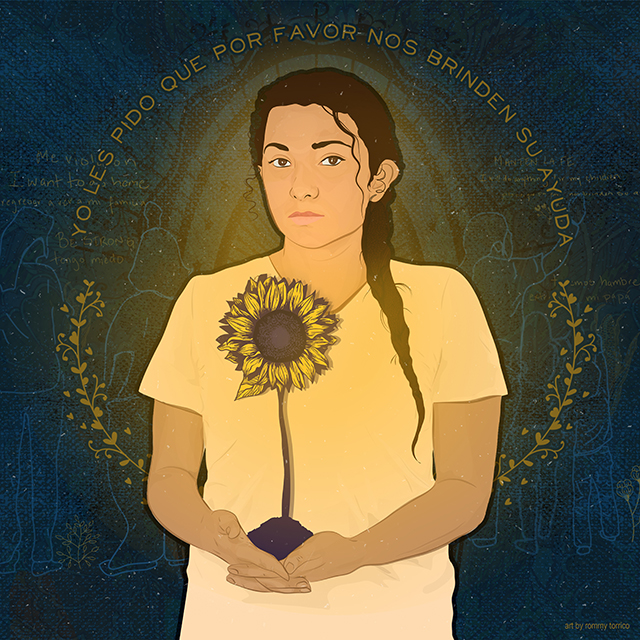 “My purpose with this piece was to recognize and celebrate the power of love and hope that burns in the hearts of [detained] women, illustrated by a single sunflower. Few of us can imagine the nightmare of what it means to be detained, of being exposed to all the violence, the darkness, the abuse and trauma. Of having to spend every day in a place where food is sometimes a luxury, where your children are scared and cold, where mothers try to remember the warmth of home to keep themselves going – a place that does its best to strip you of all your dignity and light little by little. These women are not victims, they are luchadoras, fighters, and we must remember that. They fight every day to protect their children and to survive the darkness. I want to honor that strength and that love, which shines bright even in the most oppressive conditions and to honor their urgent request for action: yo les pido que por favor nos brinden su ayuda// I ask you to please help us.” (Image: Rommy Torrico / CultureStrike)
“My purpose with this piece was to recognize and celebrate the power of love and hope that burns in the hearts of [detained] women, illustrated by a single sunflower. Few of us can imagine the nightmare of what it means to be detained, of being exposed to all the violence, the darkness, the abuse and trauma. Of having to spend every day in a place where food is sometimes a luxury, where your children are scared and cold, where mothers try to remember the warmth of home to keep themselves going – a place that does its best to strip you of all your dignity and light little by little. These women are not victims, they are luchadoras, fighters, and we must remember that. They fight every day to protect their children and to survive the darkness. I want to honor that strength and that love, which shines bright even in the most oppressive conditions and to honor their urgent request for action: yo les pido que por favor nos brinden su ayuda// I ask you to please help us.” (Image: Rommy Torrico / CultureStrike)
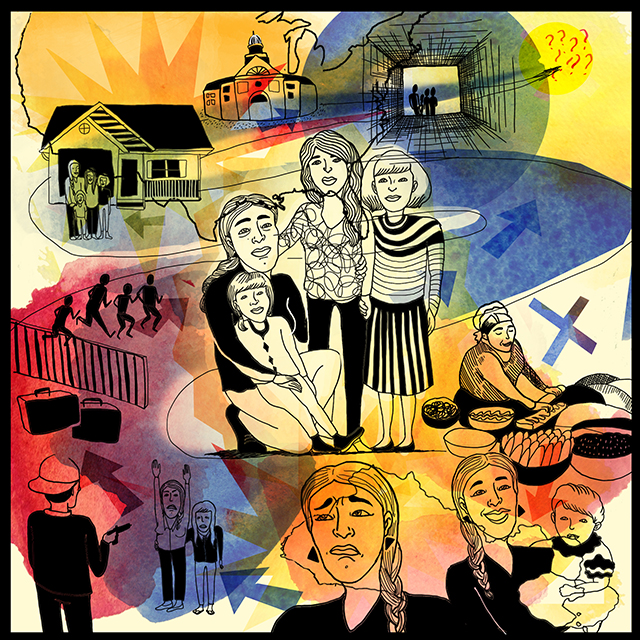 “I want the audience to capture the journey this family has gone through – from the violence they experienced in their home country and natural desire for change, to the courage it takes to move from somewhere unsafe and come to the US – and then the juxtaposition of the ‘hopes’ for a safe haven versus the reality of the situation.” (Image: Rose Jaffe / CultureStrike)
“I want the audience to capture the journey this family has gone through – from the violence they experienced in their home country and natural desire for change, to the courage it takes to move from somewhere unsafe and come to the US – and then the juxtaposition of the ‘hopes’ for a safe haven versus the reality of the situation.” (Image: Rose Jaffe / CultureStrike)
Join us in defending the truth before it’s too late
The future of independent journalism is uncertain, and the consequences of losing it are too grave to ignore. To ensure Truthout remains safe, strong, and free, we need to raise $46,000 in the next 7 days. Every dollar raised goes directly toward the costs of producing news you can trust.
Please give what you can — because by supporting us with a tax-deductible donation, you’re not just preserving a source of news, you’re helping to safeguard what’s left of our democracy.